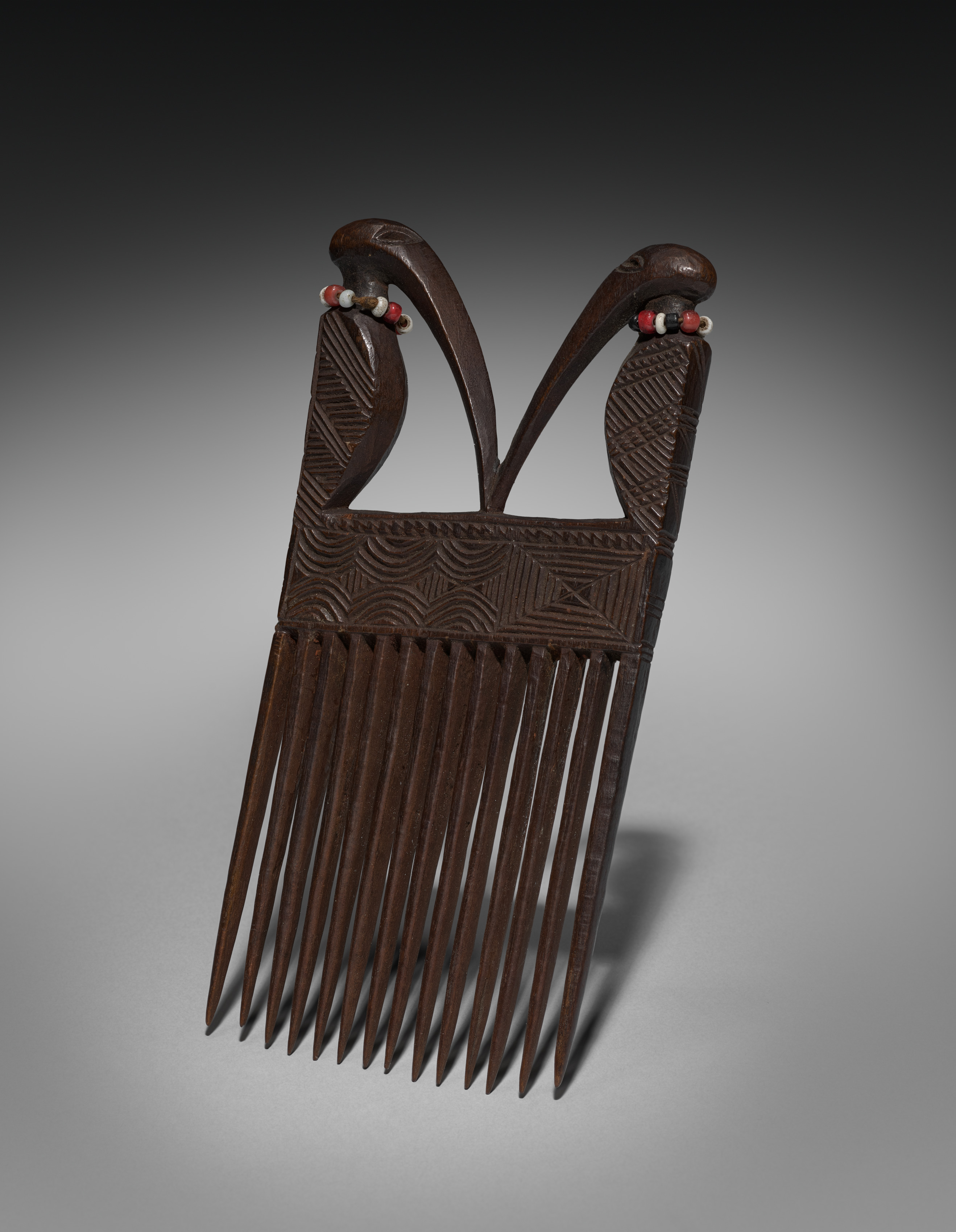The Cleveland Museum of Art
Collection Online as of April 25, 2024

Comb (cisakulo)
mid- to late 1800s
Overall: 13.3 x 8 x 1.4 cm (5 1/4 x 3 1/8 x 9/16 in.)
Location: not on view
Did You Know?
The double birds on this comb are the ngungu, a kind of hornbill linked to hunting and the related power of leaders. They were considered a good omen, and served as mediators between the earthly world and the spiritual one.Description
Chokwe women and men inserted finely decorated combs and pins in their hair to signal rank and wealth. Here, as among neighboring peoples, hairstyles reflected changing trends across place and over time. This comb's wooden material and sculptural top made it of a higher value than simple examples made from metal or cane. Its wide teeth were practical, securing elements of a hairstyle in place. The long-beaked ngungu birds with beaded necklaces were a well-known symbol of chiefly power. In addition to being a sign of beauty and good health, a well-styled hairdo also suggests that the wearer relies on the help of others in its creation. Combs were often gifted to women by admirers or husbands to mark important life events. This comb entered the Cleveland Museum of Art's collection in 1915, one year before the museum opened its doors.- by 1915(F. M. Rapp, probably by field collection in Portuguese West Africa (Angola) or Belgian Congo (Democratic Republic of Congo), sold to the Cleveland Museum of Art)1915-The Cleveland Museum of Art, Cleveland, OHProvenance Footnotes1 "In the spring of 1916, Mr. F. M. Rapp, mining engineer, now at Tonopah, Nevada, returned from the Belgian Congo, Central Africa, where he has been engaged for two years in geological work along the Kasai River and its tributaries."M. G. Edwards, "Diamond-bearing gravel from Belgian Congo," American Mineralogist (1917) 2 (7): 88–89.
- Wixom, WIlliam D. "African Art at the Cleveland Museum of Art." African Arts. 10, no. 3. (April 1977) 16-25. Mentioned and Reproduced: p.16, fig. 1 www.jstor.orgDonley, Gregory M., "A New Face for African Art", Cleveland Museum of Art. Cleveland Art: The Cleveland Museum of Art Members Magazine. Vol. 42 no. 04, April 2002 Mentioned & reproduced: p. 6-7 archive.orgPetridis, Constantijn. South of the Sahara: selected works of African art. Cleveland: Cleveland Museum of Art, 2003. Reproduced: cat. 34, p. 98 - 99Cleveland Museum of Art. The CMA Companion: A Guide to the Cleveland Museum of Art. Cleveland: Cleveland Museum of Art, 2014. Mentioned and reproduced: P. 40-41Rondeau, James, Constantijn Petridis, Yaëlle Biro, Herbert M. Cole, Kassim Kone, Babatunde Lawal, Wilfried Van Damme, and Susan Mullin Vogel. The language of beauty in African art. 2022.
- The Language of Beauty in African Art. Kimbell Art Museum, Fort Worth, TX (April 3-July 31, 2022) https://kimbellart.org/exhibition/language-beauty-african-art; The Art Institute of Chicago, Chicago, IL (organizer) (November 20, 2022-February 27, 2023) https://www.artic.edu/exhibitions/9344/the-language-of-beauty-in-african-art.
- {{cite web|title=Comb (cisakulo)|url=false|author=|year=mid- to late 1800s|access-date=25 April 2024|publisher=Cleveland Museum of Art}}
Source URL:
https://www.clevelandart.org/art/1915.453